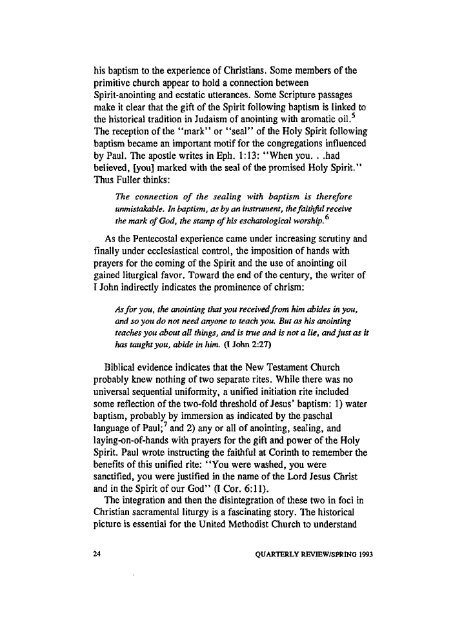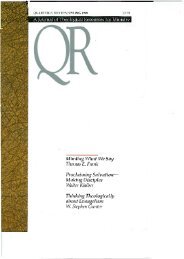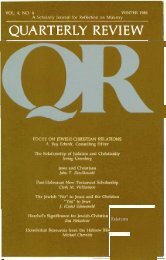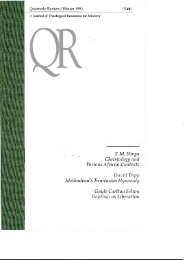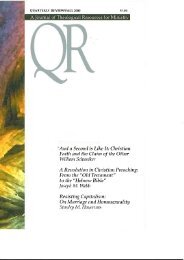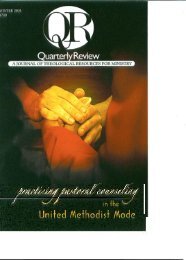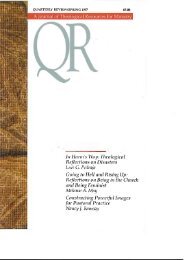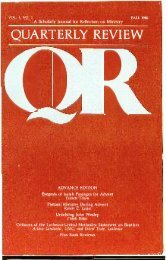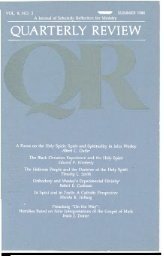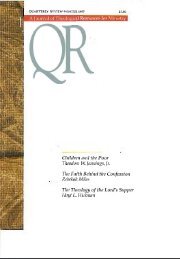TJieodore W. Jennings, Jr. The Meaning of ... - Quarterly Review
TJieodore W. Jennings, Jr. The Meaning of ... - Quarterly Review
TJieodore W. Jennings, Jr. The Meaning of ... - Quarterly Review
You also want an ePaper? Increase the reach of your titles
YUMPU automatically turns print PDFs into web optimized ePapers that Google loves.
his baptism to the experience <strong>of</strong> Christians. Some members <strong>of</strong> the<br />
primitive church appear to hold a connection between<br />
Spirit-anointing and ecstatic utterances. Some Scripture passages<br />
make it clear that the gift <strong>of</strong> the Spirit following baptism is linked to<br />
the historical tradition in Judaism <strong>of</strong> anointing with aromatic oil. 5<br />
<strong>The</strong> reception <strong>of</strong> the "mark" or "seal" <strong>of</strong> the Holy Spirit following<br />
baptism became an important motif for the congregations influenced<br />
by Paul. <strong>The</strong> apostle writes in Eph. 1:13: "When you. . .had<br />
believed, [you] marked with the seal <strong>of</strong> the promised Holy Spirit."<br />
Thus Fuller thinks:<br />
<strong>The</strong> connection <strong>of</strong> the sealing with baptism is therefore<br />
unmistakable. In baptism, as by an instrument, thefaithful receive<br />
the mark <strong>of</strong> God, the stamp <strong>of</strong> his eschatological worship?<br />
As the Pentecostal experience came under increasing scrutiny and<br />
finally under ecclesiastical control, the imposition <strong>of</strong> hands with<br />
prayers for the coming <strong>of</strong> the Spirit and the use <strong>of</strong> anointing oil<br />
gained liturgical favor. Toward the end <strong>of</strong> the century, the writer <strong>of</strong><br />
I John indirectly indicates the prominence <strong>of</strong> chrism:<br />
As for you, the anointing that you received from him abides in you,<br />
and so you do not need anyone to teach you. But as his anointing<br />
teaches you about all things, and is true and is not a lie, and just as it<br />
has taught you, abide in him. (I John 2:27)<br />
Biblical evidence indicates that the New Testament Church<br />
probably knew nothing <strong>of</strong> two separate rites. While there was no<br />
universal sequential uniformity, a unified initiation rite included<br />
some reflection <strong>of</strong> the two-fold threshold <strong>of</strong> Jesus' baptism: 1) water<br />
baptism, probably by immersion as indicated by the paschal<br />
language <strong>of</strong> Paul; 7<br />
and 2) any or all <strong>of</strong> anointing, sealing, and<br />
laying-on-<strong>of</strong>-hands with prayers for the gift and power <strong>of</strong> the Holy<br />
Spirit. Paul wrote instructing the faithful at Corinth to remember the<br />
benefits <strong>of</strong> this unified rite: "You were washed, you were<br />
sanctified, you were justified in the name <strong>of</strong> the Lord Jesus Christ<br />
and in the Spirit <strong>of</strong> our God" (I Cor. 6:11).<br />
<strong>The</strong> integration and then the disintegration <strong>of</strong> these two in foci in<br />
Christian sacramental liturgy is a fascinating story. <strong>The</strong> historical<br />
picture is essential for the United Methodist Church to understand<br />
24 QUARTERLY REVIEW/SPRING 1993


